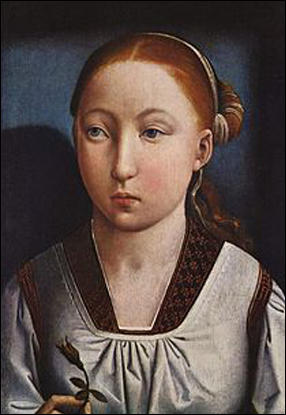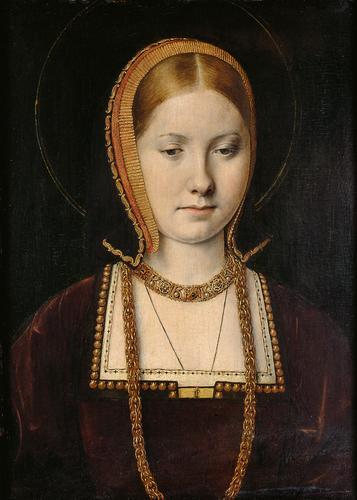The Marriage of Prince Arthur and Catherine of Aragon
Henry VII was crowned on the battlefield with the crown that belonged to the Richard III. The parliament which met on 7th November asserted the legitimacy of Henry's title and annulled the instrument embodying Richard III's title to the throne. On 10th December 1485, the House of Commons, through their speaker Thomas Lovell, urged the king to act on his promise to marry "that illustrious lady Elizabeth, daughter of King Edward IV" and so render possible "the propagation of offspring from the stock of kings".
Henry married Elizabeth of York and on 19th September 1486 she gave birth to a son, Prince Arthur. Spain, along with France, were the two major powers in Europe. Henry VII constantly feared an invasion from his powerful neighbour. Ferdinand of Aragon and Isabella of Castile were also concerned about the possible expansionism of France and responded favourably to Henry's suggestion of a possible alliance between the two countries. In 1487 King Ferdinand agreed to send ambassadors to England to discuss political and economic relations.
In March 1488, the Spanish ambassador at the English court, Roderigo de Puebla, was instructed to offer Henry a deal. The proposed treaty included the agreement that Henry's eldest son, Arthur, should marry Catherine of Aragon in return for an undertaking by Henry to declare war on France. Henry enthusiastically "showed off his nineteen-month-old son, first dressed in cloth of gold and then stripped naked, so they could see he had no deformity."
The Treaty of Medina del Campo was signed on 27th March 1489. It established a common policy towards France, reduced tariffs between the two countries and agreed a marriage contract between Prince Arthur and Catherine of Aragon and also established a dowry for Catherine of 200,000 crowns. This was a good deal for Henry. At this time, England and Wales had a combined population of only two and a half million, compared to the seven and a half million of Castile and Aragon, and the fifteen million of France. Ferdinand's motivation was that Spanish merchants wishing to reach the Netherlands, needed the protection of English ports if France was barred to them. The English also still controlled the port of Calais in northern France.
Primary Sources

(Source 2) Antonia Fraser, The Six Wives of Henry VIII (1992)
The first overtures concerning the marriage of Henry's son Arthur Prince of Wales to Ferdinand's daughter Catherine probably came as early as 1487 when Arthur (born in September 1486) was under a year old, and Catherine not yet two. On the surface there was steady progress. In April 1488 a commission was given to Dr Roderigo Gonzalva de Puebla, a middle-aged Castilian with a decent record of government service in Spain, and an excellent grasp of languages. Together with an assistant, he was to draft a treaty of marriage with the commissioners of the English King....
In an age when marriages were frequently contracted for reasons of state between children or those hovering between childhood and adolescence, more care rather than less was taken over the timing of consummation. Once the marriage was officially completed, some years might pass before the appropriate moment was judged to have arrived. Anxious reports might pass between ambassadors on physical development; royal parents might take advice on their offsprings' readiness for the ordeal. The comments - sometimes remind one of those breeders discussing the mating of thoroughbred stock, and the comparison is indeed not so far off. The siring of progeny was the essential next step in these royal marriages, so endlessly negotiated.
(Source 3) Roderigo de Puebla comment made to Henry VII (1488)
Bearing in mind what happens every day to the kings of England, it is surprising that Ferdinand and Isabella should dare think of giving their daughter at all.
(Source 4) David Loades, The Six Wives of Henry VIII (2007)
The marriage of a ruler was the highest level of the matrimonial game, and carried the biggest stakes, but it was not the only level. Both sons and daughters were pieces to be moved in the diplomatic game, which usually began while they were still in their cradles. A daughter, particularly, might undergo half a dozen betrothals in the interests of shifting policies before her destiny eventually caught up with her.
(Source 5) Alison Weir, The Six Wives of Henry VIII (2007)
In 1493, when Catherine was seven years old, it had been decided that she would go to England in 1498, when she was twelve... In April 1501, Queen Isabella announced that her daughter was ready... Catherine arrived in Plymouth on 2nd October 1501.

(Source 7) Prince Arthur, letter to Catherine of Aragon (October 1499)
I cannot tell you what an earnest desire I feel to see your Highness, and how vexatious to me is this procrastination about your coming. Let it be hastened, that the love conceived between us and the wished-for joys may reap their proper fruit.
(Source 8) Alison Plowden, Tudor Women (2002)
As a girl she had been pretty, small and well-made, with a clear pink and white skin and quantities of russet-coloured hair, which the chronicler Edward Hall had specially noticed as being "of a very great length, beautifully and goodly to behold".
(Source 9) Hilary Mantel, Anne Boleyn (11th May, 2012)
Catherine was the daughter of two reigning monarchs: educated, gracious and regal, she had been trained for queenship and saw it as her vocation. She had been a tiny auburn-haired beauty when she came to England.
Questions for Students
Question 1: Read the introduction and explain why Henry VII started arranging the marriage of his son soon after he was born.
Question 2: Study sources 3 and 4. Explain why Ferdinand of Aragon and Isabella of Castile were worried about sending their young daughter to England.
Question 3: Why were arranged marriages between the sons and daughters of European royal families often cancelled?
Question 4: Describe the feelings of Prince Arthur that are expressed in source 7.
Question 5: Do sources 1 and 6 support the opinions expressed in sources 8 and 9?
Question 6: Study sources 2 and 5. Create a timeline entitled "The marriage of Arthur Tudor and Catherine of Aragon" that includes the dates: 1487, 1488, 1493, 1498 and 1501.
Question 7: Use the information in this unit to explain why Arthur and Catherine did not get married before 1501?
Answer Commentary
A commentary on these questions can be found here
Download Activity
You can download this activity in a word document here
You can download the answers in a word document here
